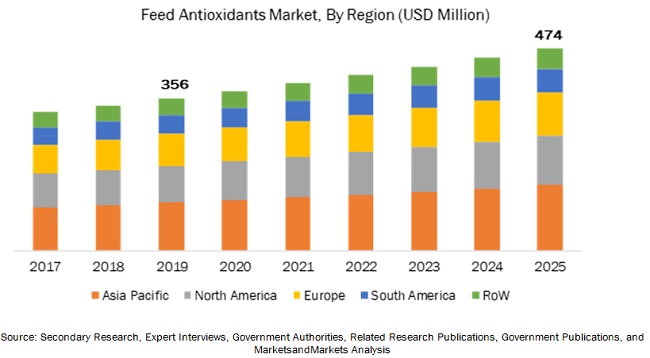The global feed antioxidants market is estimated to be valued at USD 356 million in 2019 and is likely to reach USD 474 million by 2025, growing at a CAGR of 4.9% during the forecast period. Factors such as the rise in demand for quality feed, improved technology for feed production, and an increase in the standardization of meat products stimulate the growth of the feed antioxidants market across the globe.

Among the animal segment, the feed antioxidants market was dominated by poultry in 2018. In poultry production, one of the major factors for feed is the cost, hence reducing feed costs per bird is a priority. Poultry production has to be efficient as feed has to be converted into meat and eggs. Feed costs can be reduced by adding feed additives such as enzymes and antioxidants, which increase digestibility and prevent the loss of nutrients, with the result that the poultry gains more nutritional value from the same amount of feed. Companies such as Cargill, Koninklijke DSM N.V., and Kemin provide feed antioxidants such as carotenoids, tocopherols, synthetic antioxidants and citric acid, BHT, butylated hydroxyanisole (BHA), and tocopheryl acetate for the poultry industry. BHT, BHA, and ethoxyquin are the most commonly used feed antioxidants for poultry.
Download PDF Brochure: https://www.marketsandmarkets.com/pdfdownloadNew.asp?id=138013648
The dry form dominated the feed antioxidants market in 2018. It experiences a higher demand among feed manufacturers, as it is easy to mix with feed, easy to store, and convenient to handle. Additionally, dry antioxidants such as powders, granules, and beadlets are more economical as compared to liquid alternatives.
The powder form of feed antioxidants dominated the dry feed antioxidants market. Powders witness higher demand as they are convenient to coat over the feed. In addition, as the size of the powder form is consistent, it helps to be coated on the feed easily. Antioxidants such as carotenoids, ethoxyquin, BHT, BHA, and TBHQ are available in this form. These antioxidants are preferred as they are also easy to use in combination with other feed antioxidants.
Asia Pacific accounted for the largest share in the feed antioxidants market. Asia, being the largest continent with a relatively fast economic development, is witnessing a rising demand for quality meat. Consequently, to produce quality meat, feed antioxidants are gaining importance. According to the Food and Agriculture Organization (FAO) 2016, the presence of a large livestock population and their growth rate drove the feed antioxidants market in the Asia Pacific region. The rise in demand for feed is leading to an increase in the number of feed mills in the region. Furthermore, countries such as India and Japan have witnessed an increase in the number of feed mills and feed production. According to the Alltech Feed Survey of 2018, the region experienced a 7% increase in its feed production from 356.5 million tons in 2012 to 381.1 million tons in 2017. While India and Japan demonstrate constant growth, China contributes to a significant share in the Asia Pacific feed production market. At the same time, Thailand and Indonesia are emerging as feed producing countries. Asia Pacific region has 80% of the global feed companies in this region. In addition, the hot and humid climate of the Asia Pacific region drives the demand for feed antioxidants. Thus, Asia Pacific is a highly competitive market in the feed antioxidants market.
Make an Inquiry: https://www.marketsandmarkets.com/Enquiry_Before_BuyingNew.asp?id=138013648
This report includes a study of marketing and development strategies along with the product portfolios of leading companies in the feed antioxidants market. It includes the profiles of leading companies such as Cargill (US), Archer Daniels Midland Company (US), Koninklijke DSM N.V. (Netherlands), BASF SE (Germany), Nutreco (Netherlands), Kemin (US), Adisseo (France), Perstorp (Sweden), Alltech (US), Caldic (Canada), Novus International (US), Chemical Fine Sciences (India), Oxiris Chemical (Spain), VDH ChemTech (India), Zhejiang Medicine (China), BTSA (Spain), Bertol Company (Czech Republic), FoodSafe Technologies (US), Videka Company (US), Lallemand Animal Nutrition (Canada), and Industrial Tecnica Pecuaria (Spain).

